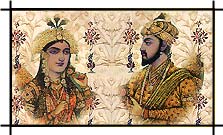TAJ MAHAL
History of Taj Mahal

The
construction of this marble masterpiece is credited to the Mughal emperor Shah
Jahan who erected this mausoleum in memory of his beloved wife, Arjumarid Bano
Begum; popularly known as Mumtaz Mahal, who died in A.H. 1040 (A.D. 1630).
Her last wish to her husband was "to build a tomb in her memory such as
the world had never seen before". Thus emperor Shah Jahan set about building
this fairy tale like marvel.
The construction of Taj Mahal was started in A.D. 1632 and completed at the
ended in 1648 A.D. For seventeen years, twenty thousand workmen are said to
have been employed on it daily, for their accommodation a small town, named
after the deceased empress- 'Mumtazabad', now known as Taj Ganj, was built adjacent
to it.
Amanat Khan Shirazi
was the calligrapher of Taj Mahal, his name occurs
at the end of an inscription on one of the gates of the Taj. Poet Ghiyasuddin
had designed the verses on the tombstone, while Ismail Khan Afridi of Turkey
was the dome maker. Muhammad Hanif was the superintendent of Masons.
The designer of Taj Mahal was Ustad Ahmad Lahauri. The material was brought
in from allover India and central Asia and it took a fleet of 1000 elephants
to transport it to the site. The central dome is 187 ft. high at the centre.
Red sandstone was brought from Fatehpur Sikri, Jasper from Punjab, Jade and
Crystal from China, Turquoise from Tibet, Lapis Lazuli and Sapphire from Sri
Lanka, Coal & Comelian from Arabia and Diamonds from Panna. In all 28 kind
of rare, semi precious and precious stones were used (or inlay work in the Taj
Mahal.
The chief building material, the white marble was brought from the quarries
of Makrana, in distt. Nagaur, Rajasthan. Copies of orders (farmans) issued to
Raja Jai Singh, for the purpose by Shah Jahan, can be seen in the Taj Museum.
Taj Mahal's outer court, also known as Jilo Khana
, was formerly used
both as a bazar and a caravansarai (Rest house). On the south-east and south-west
comers are the tombs of Sirhindi Begum and Satiunnisa Khanum. The Taj has a
jewel-like quality.
The shadow and light play demonstrates its many moods.
Some feel the Taj is best seen on a full moon night, others find it ethereal
at dawn while some insist that it is sensuous at sunset.
